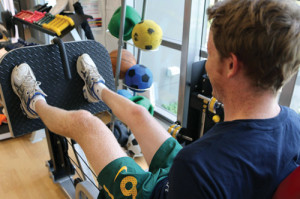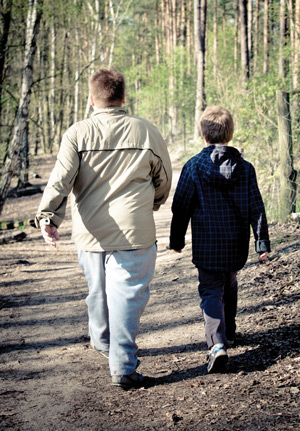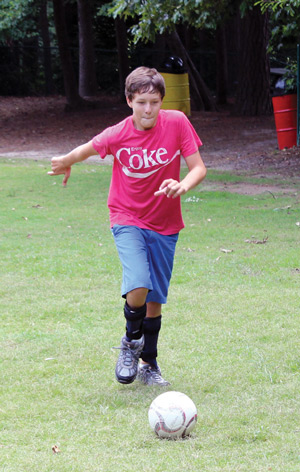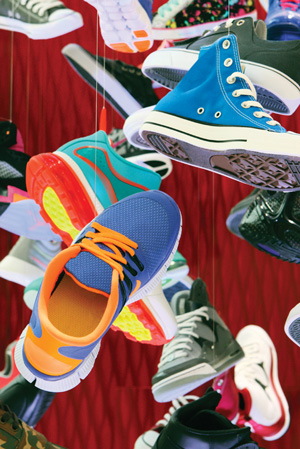![2PEDS-CP-Figure-3]() Research suggests strength training can improve gait and function in children with cerebral palsy. But to be successful, experts say, the training needs to be part of a multifaceted rehabilitation program that accounts for more than the physical limitations imposed by the disease.
Research suggests strength training can improve gait and function in children with cerebral palsy. But to be successful, experts say, the training needs to be part of a multifaceted rehabilitation program that accounts for more than the physical limitations imposed by the disease.
By Shalmali Pal
The merits and drawbacks of strength training in children with spastic cerebral palsy (CP) have been the subject of debate, but Tyler Sexton, MD, has no doubts about its benefits.
Diagnosed with spastic diplegia, the most common form of CP, Sexton underwent 16 surgeries during his formative years, including selective dorsal rhizotomy at age 4 years, which helped him trade in a wheelchair for a walker; Achilles tendon lengthening; hamstring and adductor lengthening; and repairs to the lateral collateral ligament and meniscus in his left knee.
“I always kept up with my strength training and aggressive physical therapy [PT] before and after my various surgeries,” Sexton explained. “I saw great improvement with strength training, specifically cycling. [It] was the best way to gain function and mobility. I rode a three-wheel bike and now I’m on a stationary bike. I still do this every day, and I’m 28.”
Gaining strength, mobility, and function gave Sexton the ability to achieve his goals: weaning himself from his ankle foot orthoses (AFOs) by age 13 years, learning to drive a car, earning the title of scuba divemaster, and becoming a pediatrician who specializes in hyperbaric medicine.
![LER-Resource-Guide-Products-CP]()
Sexton, president and chief executive officer of Caribbean Hyperbaric Medicine in Zephyrhills, FL, and a clinical professor of hyperbaric medicine at the University of Southern Alabama in Mobile, now works with children with disabilities, including CP, and is an advocate for strength training.
“I believe it does help with mobility and spasticity,” he said. “I know the literature hasn’t always found that to be true, but…I believe in the ability of strength training in CP. In myself and my patients, I’ve seen an increase in range of motion, a decrease in pain in the hips and knees, and an increase in endurance.”
One piece of the puzzle
![Figure 1. A teenage patient with CP performs lower body strength training. (Image courtesy of the Cerebral Palsy Alliance.)]()
Figure 1. A teenage patient with CP performs lower body strength training. (Image courtesy of the Cerebral Palsy Alliance.)
But Sexton, along with the other experts that LER spoke with, doesn’t believe strength training (with diplegia or hemiplegia) is the ultimate panacea for gait and function issues in kids with CP. For strength training to be successful in this patient population, experts say, it needs to be part of a multifaceted rehabilitation program that takes into consideration more than the physical limitations imposed by the disease state.
“Children with CP are weak almost everywhere, so why not try to get them as strong as their able-bodied peers? Then get them to apply that strength and flexibility to whatever they want to do in their lives,” commented Jack Engsberg, PhD, director of the Human Performance Lab at Washington University in St. Louis. “I think the same principles for strength training that apply to people without disabilities apply to those with disabilities. But you have to consider what the disabilities are, and design a program based upon that.”
The goal of strength training in children with CP is not to produce the same results as body builders, stressed Christopher Joseph, MSPT, director of PT at the Kennedy Krieger Institute in Baltimore.
“We are looking to strengthen them within their abilities,” Joseph said.
Orthopedic surgeon Lance Silverman, MD, of Silverman Foot & Ankle in Edina, MN, said he is a believer in postsurgical PT in general, but cautioned, “Strength training by itself is a mistake because it will only strengthen the dysfunction instead of properly correcting the problem.”
A sound strength-training regimen will correct dysfunctional movement and then work to improve functional movement, Silverman explained.
“It is the same process that would be used with a healthy population; it’s just more challenging to do correctly with CP patients,” he said.
Patient selection
Study results for strength training in children CP have been mixed.1-6 Authors of a 2012 meta-analysis7 concluded that, while some individuals benefit from progressive strength training, it’s unlikely to be the optimal therapy for all patients with CP.
Engsberg, who is also a professor of occupational therapy, neurosurgery, and orthopedics, suggested the studies that did not show a good result from strength training did not aim for enough of a strength increase.
“These kids are already at thirty percent in terms of strength versus able-bodied kids, so a ten percent increase isn’t going to really benefit them,” he said. “You want to show a dramatic change in the strength component—sixty percent or more—so you have to tailor the training accordingly.”
But the experts agreed with the meta-analysis authors that patient selection is key. For example, kids with a Gross Motor Function Classification System (GMCFS) score of IV or V—in which independent mobility is either very limited or nonexistent—may not be good candidates for strength training.
“If I have a patient who I do not expect to walk after surgery, then I’m less likely to say that strength training is worthwhile,” Silverman said. “If I have a patient who I expect to have a productive gait after surgery, but is having a difficult time with balance and coordination, then I think strength training has value.”
The International Classification of Functioning, Health and Disability (ICF) has become a common tool for assessing disability, and ultimately, a child’s capacity for strengthening.
“The ICF considers the body structures and function aspect of a health condition/disability, the impact on activity, and the impact on participation,” explained Prue Golland, a consultant in physiotherapy at the Cerebral Palsy Alliance in Allambie Heights in New South Wales, Australia, in an email. “In simple terms, muscle weakness is considered to occur at the body structures level whilst walking is at the activity level. The literature8 suggests that interventions are generally effective at one level of the ICF only.”
Age and CP-related cognitive deficits are also considerations with regard to the child’s ability to follow directions.
Joseph explained that, at a very young age, most children with CP still learning effective motor patterns. If they struggle early on, that can lead to muscle weakness.
“When we start strengthening at an early age, we do it in a functional context. We’ll load them with a weight or put them in a context where they have to carry most of their body weight,” he said. “For instance, walking up steps. We may not start steps with a healthy eight-month-old because they can’t walk, but we may start steps in an eight-month-old CP kid because we want to strengthen the thighs and calves, and have the child learn the correct motor pattern.”
At the Cerebral Palsy Alliance, therapists reserve progressive resistance strength training for children older than 8 years; functional strength programs utilizing goal-directed therapy are used in younger children, Golland said.
Finally, Sexton said he does not advise strength training in children whose CP is complicated by severe cardiac abnormalities or bronchopulmonary dysplasia or in those with self-harming behavior.
Factors to consider
Strengthening programs are generally based on the guidelines from the American Academy of Pediatrics and the National Strength and Conditioning Association, Golland pointed out. But training approaches and protocols still need to be determined on a case-by-case basis.
At Kennedy Krieger, therapists use both the split treadmill and aquatherapy for strength training.
![Figure 2. Tyler Sexton, MD, chats with a patient. (Photo by Bill Starling.)]()
Figure 2. Tyler Sexton, MD, chats with a patient. (Photo by Bill Starling.)
While motor activity is the primary aim of a split treadmill workout, it can offer some benefits for endurance and strengthening, Joseph said.
“Let’s say the child is hemiparetic on the right side. I can set her up so that the treadmill is going at the normal speed—about 1.5 to 2.2 miles per hour for an average child—on the left side. On the right, I can speed the treadmill up so that she has to concentrate more on that right leg,” he said.
A CP patient who has severe contraction and is unable to passively move her limbs may not be a candidate for cycling therapy, Sexton said, and would be better served by aquatic therapy or even resistance band training.
Sexton said he believes an effective strength-training regimen will incorporate antispastic medication, such as onabotulinumtoxinA (Botox) and baclofen. However, he emphasized that dosing of antispastics must be titrated properly to help control spasticity without limiting the patient’s ability to work their muscle groups and follow the training protocol.
Joseph concurred.
“Some kids use their spasticity and their muscle tone, even if it’s low, to function,” he said. “We don’t want to completely take away their spasticity and that muscle tone.”
AFOs can be a help or a hindrance, depending on the patient. Engsberg pointed out that, if a patient is wearing a rigid AFO but is trying to gain more ankle strength, then the AFO isn’t going to help with the latter if it prevents ankle motion.
“However, if a child is unable to walk without the AFO, then perhaps the goal with ankle strengthening might be to transition away from the rigid AFO to a flexible one,” he said.
And, even if an AFO does restrict ankle movement, the added stability may facilitate strengthening the muscles around the knee or hip, Golland said.
Joseph said that his group is getting away from orthoses in general and setting patients up with functional electrical stimulation (FES) units, in some cases while the patient is still wearing a postoperative cast.
“If we have concerns about the muscle getting weaker, we’ll cut a window in the cast and apply the FES, working within the parameters set by the physician,” Joseph said.
Time
One limitation of the published studies in this area is that the duration of strength training—generally around eight weeks—may not have been long enough for researchers to see visible functional improvements.
This is particularly true for patients who have recently undergone postoperative casting, Silverman said.
“It’s going to be several weeks after surgery before a CP patient is going to be able to recoordinate the body. You have to keep that timeline in mind before you determine when to begin strength training and how long it should be done,” he said.
Engsberg explained that a strength training protocol starts with learning proper technique, which in itself can take a couple of months.
“Then you start getting into the building of muscle mass,” he said. “So strength training programs that only go for four or six weeks are not really getting into the two important components that make strength training worthwhile.”
Rather than keeping a strict timeline for seeing results, the therapists at Kennedy Krieger follow the child’s progress in terms of functional gains, bearing in mind that, the younger the child, the more time progress will require.
“If we have a CP child who walks at age two, we’re going to work with them from twelve to sixteen months on strengthening in a functional context,” Joseph said. “As they get older, then we may be able to focus on a more traditional strengthening protocol because they can follow directions better.”
Sexton also emphasizes to his patients and their caregivers that they may not see the benefits of strength training in the short term.
“In the long run, they will have better mobility; they will have better range of motion. All of that is more likely to get them closer to their goals,” he said.
Goals and motivation
Sexton pointed out that many children with CP have the same hopes and dreams as kids without CP, which can be an important consideration in training.
“I wanted to be [basketball player] Shaquille O’Neal when I was younger,” he shared. “I remember the therapists would say to me, ‘Come on, Shaq, let’s do it,’ when I tried to get out of the wheelchair and walk. Was that the only thing that got me out of the wheelchair? No, but finding out what motivates a kid with CP and incorporating that into the strength training protocol is very important.”
For very young children who can’t communicate their goals, “you have to follow their lead and engage them as they are moving. Find out what seems to interest them, whether it’s walking the steps or being in the water,” Joseph said.
For some CP patients—especially those with GMFCS classification I or II—the goal may not be to improve function, but simply to maintain it, Golland said.
“Does function mean walking, getting up from the floor, or climbing stairs? Or does it refer to someone’s ability to reposition themselves in their wheelchair, or lean forward to assist a carer to reposition their clothing?”
Even small gains in strength may be empowering to a patient with CP.
“Let’s say a CP child is going through a calisthenics-based strength training program, but they’re only seeing a ten percent gain,” Sexton said. “From a clinical perspective, that may not be meaningful. But maybe that small gain allows that kid to feel like he can go out for a walk with his dad or do some other activity.”
Joseph noted that patient-centered quality of life is becoming essential for measuring the success of a training program.
“That kind of information about the child and his real-life situation can be much more useful [than more clinical measures] when I look at what is, and is not, working for the child,” he said.
Shalmali Pal is a freelance writer based in Tucson, AZ.
REFERENCES
- Engsberg JR, Ross SA, Collins DR. Increasing ankle strength to improve gait and function in children with cerebral palsy: a pilot study. Pediatr Phys Ther 2006;18(4):266-275.
- Unger M, Faure M, Frieg A. Strength training in adolescent learners with cerebral palsy: a randomized controlled trial. Clin Rehabil 2006;20(6):469-477.
- Eek MN, Tranberg R, Zügner R, et al. Muscle strength training to improve gait function in children with cerebral palsy. Dev Med Child Neurol 2008;50(10):759-764.
- Damiano DL, Arnold AS, Steele KM, Delp SL. Can strength training predictably improve gait kinematics? A pilot study on the effects of hip and knee extensor strengthening on lower-extremity alignment in cerebral palsy. Phys Ther 2010;90(2):269-279
- Scholtes VA, Becher JG, Comuth A, et al. Effectiveness of functional progressive resistance exercise strength training on muscle strength and mobility in children with cerebral palsy: a randomized controlled trial. Dev Med Child Neurol 2010;52(6):e107-e113.
- Scholtes VA, Becher JG, Janssen-Potten YJ, et al. Effectiveness of functional progressive resistance exercise training on walking ability in children with cerebral palsy: a randomized controlled trial. Res Dev Disabil 2012;33(1):181-188.
- Steele KM, Damiano DL, Eek MN, et al. Characteristics associated with improved knee extension after strength training for individuals with cerebral palsy and crouch gait. J Pediatr Rehabil Med 2012;5(2):99-106.
- Scholtes VA, Dallmeijer AJ, Rameckers EA, et al. Lower limb strength training in children with cerebral palsy–a randomized controlled trial protocol for functional strength training based on progressive resistance exercise principles. BMC Pediatr 2008;8:8:41.



 Research suggests strength training can improve gait and function in children with cerebral palsy. But to be successful, experts say, the training needs to be part of a multifaceted rehabilitation program that accounts for more than the physical limitations imposed by the disease.
Research suggests strength training can improve gait and function in children with cerebral palsy. But to be successful, experts say, the training needs to be part of a multifaceted rehabilitation program that accounts for more than the physical limitations imposed by the disease.


 Australian researchers found no correlation between body mass index and prevalence of pediatric flatfoot, but used a different methodology than previous studies that reached an opposite conclusion. The conflicting results have revitalized the ongoing debate on this topic.
Australian researchers found no correlation between body mass index and prevalence of pediatric flatfoot, but used a different methodology than previous studies that reached an opposite conclusion. The conflicting results have revitalized the ongoing debate on this topic. Obesity, gender affect tear complexity
Obesity, gender affect tear complexity



 Austrian research suggests too-short shoes may contribute to the development of bunions in children, and genetics also appear to play a role. Most clinicians try to avoid surgery in young patients, instead turning to conservative strategies such as foot orthoses and night splints.
Austrian research suggests too-short shoes may contribute to the development of bunions in children, and genetics also appear to play a role. Most clinicians try to avoid surgery in young patients, instead turning to conservative strategies such as foot orthoses and night splints.
 By Jordana Bieze Foster
By Jordana Bieze Foster
 But exercises may not help those with CAI
But exercises may not help those with CAI By Jordana Bieze Foster
By Jordana Bieze Foster Nordic exercise could be used for screening
Nordic exercise could be used for screening By Jordana Bieze Foster
By Jordana Bieze Foster ‘Comfort filter’ may reduce injury risk
‘Comfort filter’ may reduce injury risk By Jordana Bieze Foster
By Jordana Bieze Foster Closing the gap between lab and field
Closing the gap between lab and field